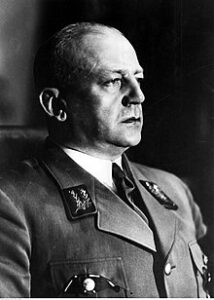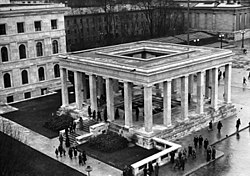Bouhler, Helene “Helli” (Majer), born 20-04-1912 in Lauingen  a region of Dillingen an der Donau, Bavaria (Bayern), Germany.
a region of Dillingen an der Donau, Bavaria (Bayern), Germany.
After the “seizure of power”, SS Obergruppenführer  and Chief of the Chancellery of the Führer of the NSDAP.
and Chief of the Chancellery of the Führer of the NSDAP.  Philipp Bouhler
Philipp Bouhler 
 was elected to the Reichstag (constituency Westphalia-South) on 05-03-1933, to which he belonged until the end of the Second World War. On 20-04-1933, Bouhler joined the general SS (SS No. 54,932) with the rank of SS-Group Leader. He was promoted to SS Obergruppenfuhrer on 30-01-1936. On 02-06-1933, Bouhler also became Reichsleiter of the NSDAP. Other additional offices were of secondary importance: Memberships in the Supreme National Sports Authority for German Motor Vehicles
was elected to the Reichstag (constituency Westphalia-South) on 05-03-1933, to which he belonged until the end of the Second World War. On 20-04-1933, Bouhler joined the general SS (SS No. 54,932) with the rank of SS-Group Leader. He was promoted to SS Obergruppenfuhrer on 30-01-1936. On 02-06-1933, Bouhler also became Reichsleiter of the NSDAP. Other additional offices were of secondary importance: Memberships in the Supreme National Sports Authority for German Motor Vehicles  as a representative of SS motorsport concerns from 1933, in the Reich Chamber of Culture and the Reich Press Chamber from 15-11-1933, and in the Academy for German Law from 19-09-1934. Probably in July 1934, Bouhler married an “attractive, charming and ambitious woman […], which drew Hitler’s attention to him again.”: Helene “Helli” Majer, born on 20-04-1912 in Lauingen
as a representative of SS motorsport concerns from 1933, in the Reich Chamber of Culture and the Reich Press Chamber from 15-11-1933, and in the Academy for German Law from 19-09-1934. Probably in July 1934, Bouhler married an “attractive, charming and ambitious woman […], which drew Hitler’s attention to him again.”: Helene “Helli” Majer, born on 20-04-1912 in Lauingen  known as the “most beautiful Woman of the Reich Chancellery”. On 29-08-1934, Bouhler was appointed chief of police in Munich, but did not take up the office again. In September 1934 he was called to Berlin and there on 17-11-1934 he was appointed head of the Führer’s new chancellery (KdF). As a private chancellery, this office was intended to emphasize Hitler’s leadership role. Requests for clemency and complaints addressed to Hitler were processed here, as were Hitler’s private affairs.
known as the “most beautiful Woman of the Reich Chancellery”. On 29-08-1934, Bouhler was appointed chief of police in Munich, but did not take up the office again. In September 1934 he was called to Berlin and there on 17-11-1934 he was appointed head of the Führer’s new chancellery (KdF). As a private chancellery, this office was intended to emphasize Hitler’s leadership role. Requests for clemency and complaints addressed to Hitler were processed here, as were Hitler’s private affairs.
Death and burial ground of Bouhler, Helene, born Maier, “Helli”.

 the bridal couple here with Generalfeldmarschall der Artillerie. Chief Oberkommando der Wehrmacht, Wilhelm Bodewin Johann Gustav Keitel
the bridal couple here with Generalfeldmarschall der Artillerie. Chief Oberkommando der Wehrmacht, Wilhelm Bodewin Johann Gustav Keitel 
 and the Gauleiter Adolf Wagner.
and the Gauleiter Adolf Wagner.
Wagner for many years suffered from the effects of chronic alcoholism, and his condition worsened in November 1941 after follow-up operations for his WWI leg injury. In June 1942 Adolf Wagner  was still recuperating and was replaced in his official duties by Paul Giesler
was still recuperating and was replaced in his official duties by Paul Giesler

 in an acting capacity on 23 June. Then at a Party rally in Traunstein on 15-07-1942, Wagner suffered a stroke that very seriously incapacitated him with impaired speech and mobility. Wagner nominally remained in his posts until a second stroke resulted in his death on 12-04-1944, age 53, at which time Giesler was named his permanent successor. The increasingly reclusive Führer made a rare public appearance to attend Wagner’s lavish funeral on 17 April at the Deutsches Museum that included a eulogy by Minister of Propaganda Josef Goebbels.
in an acting capacity on 23 June. Then at a Party rally in Traunstein on 15-07-1942, Wagner suffered a stroke that very seriously incapacitated him with impaired speech and mobility. Wagner nominally remained in his posts until a second stroke resulted in his death on 12-04-1944, age 53, at which time Giesler was named his permanent successor. The increasingly reclusive Führer made a rare public appearance to attend Wagner’s lavish funeral on 17 April at the Deutsches Museum that included a eulogy by Minister of Propaganda Josef Goebbels.  The deceased Gauleiter was posthumously awarded the German Order, the Nazi Party’s highest decoration. He was buried near the Ehrentempel (Honor Temples)
The deceased Gauleiter was posthumously awarded the German Order, the Nazi Party’s highest decoration. He was buried near the Ehrentempel (Honor Temples) 
 which housed the remains of those killed in the Beer Hall Putsch.
which housed the remains of those killed in the Beer Hall Putsch.
 Wedding guests.
Wedding guests.
Front row, left-right – Heinrich Hoffmann, 
 Gretl Braun, she married Kurt Berlinghoff
Gretl Braun, she married Kurt Berlinghoff 
 Dr. Theo Morell, Frau Bouhler, Phillip Bouhler, Gerda Bormann-Buch,
Dr. Theo Morell, Frau Bouhler, Phillip Bouhler, Gerda Bormann-Buch,  Adolf Hitler, Eva Braun, Martin Bormann, Anni Brandt; 2nd row – Christa Schroeder,
Adolf Hitler, Eva Braun, Martin Bormann, Anni Brandt; 2nd row – Christa Schroeder,  Freda Kannenberg, Albert Speer, Margarete Speer,
Freda Kannenberg, Albert Speer, Margarete Speer,  Hanni Morell, Frau Schmundt, Ilse Braun, Hitler’s Deputy Chief Press Secretary Heinz Lorenz; 3rd row – Ludwig Bahls (SS Aide), Gerda Daranowski, Albert Bormann, Jacob Werlin (managing director of Daimler-Benz), Sofie Stork, an artist friend of Hitler’s who was very often part of his inner circle., Fritz Schönmann, the husband of Marion Schönmann, a girlfried of Eva Baun, General Rudolf Schmundt
Hanni Morell, Frau Schmundt, Ilse Braun, Hitler’s Deputy Chief Press Secretary Heinz Lorenz; 3rd row – Ludwig Bahls (SS Aide), Gerda Daranowski, Albert Bormann, Jacob Werlin (managing director of Daimler-Benz), Sofie Stork, an artist friend of Hitler’s who was very often part of his inner circle., Fritz Schönmann, the husband of Marion Schönmann, a girlfried of Eva Baun, General Rudolf Schmundt

 Hitler’s Wehrmacht adjutant), Marianne Schönmann, Dr. Karl Brandt, Arthur (“Willi”) Kannenberg.
Hitler’s Wehrmacht adjutant), Marianne Schönmann, Dr. Karl Brandt, Arthur (“Willi”) Kannenberg.
American troops arrested Bouhler  and the entire Goering entourage on 09-05-1945 at Fischhorn Castle near Zell am See.
and the entire Goering entourage on 09-05-1945 at Fischhorn Castle near Zell am See.  Philipp Bouhler was arrested on 19-05-1945. On the way to the Dachau internment camp, probably Bouhler and his wife committed suicide shortly before their arrival, Phillipp using a hydrocyanic acid capsule. “Heli” jumped out of a window from Schloss Fischhorn and a young American Leutnant removed her diamond rings from her fingers. The couple had no children.
Philipp Bouhler was arrested on 19-05-1945. On the way to the Dachau internment camp, probably Bouhler and his wife committed suicide shortly before their arrival, Phillipp using a hydrocyanic acid capsule. “Heli” jumped out of a window from Schloss Fischhorn and a young American Leutnant removed her diamond rings from her fingers. The couple had no children.
Helene “Helli” Bouhler was not buried at Dachau K as was said. She was initially buried in an unmarked grave nearby Schloss Fischhorn near Bruck an der Großglocknerstraße. Bruck is a municipality in Zell am See District of Austria. Probably Helli’s remains were exhumed by the family in 1951 and reinterred at the Waldfriedhof München. Phillip Bouhler name is on the family grave also ??.


















Leave a Reply